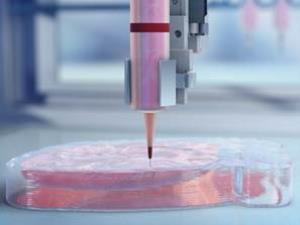



Date:28/10/19
 An important development has been made in the field of ‘bioprinting’ which could have a major impact on medical research, and even the ability to produce tailor-made tissue.
An important development has been made in the field of ‘bioprinting’ which could have a major impact on medical research, and even the ability to produce tailor-made tissue.
Bioprinting refers to having actual cells embedded in a 3D-printed framework, with a new high-resolution process having just been discovered.
As highlighted by Science Daily, researchers at the Vienna University of Technology (TU Wien) have engineered a high-resolution bioprinting process using a special ‘bio ink’ with cells able to be embedded in a 3D framework printed with micrometer precision.
What’s more, this method is far faster than previous bioprinting efforts, with a print speed of 1m per second.
Embedding cells in such a 3D framework is a very useful way of investigating the behavior of cells, and aspects like tissue growth, or studying diseases – and a bioprinted structure is a great way to do this.
The researchers at TU Wien based their high-resolution advance on “two-photon polymerization methods”, a process well-suited to producing very fine 3D structures with high precision.
The drawback is that traditionally this high-resolution printing is extremely slow, perhaps only managing to print a few millimeters per second, and the problem then is the survival of the cells.
There’s only a good chance of the cells actually surviving if the printing process can be completed within a few hours, so boosting print speeds from millimeters to a whole meter per second is obviously a giant leap forward.
Professor Aleksandr Ovsianikov, head of the 3D Printing and Biofabrication research group at the Institute of Materials Science and Technology (TU Wien), commented: “Using these 3D scaffolds, it is possible to investigate the behavior of cells with previously unattainable accuracy. It is possible to study the spread of diseases, and if stem cells are used, it is even possible to produce tailor-made tissue in this way.”
So obviously the implications are far-reaching indeed for medical research and beyond…
3D printing could be used to print human tissue
 An important development has been made in the field of ‘bioprinting’ which could have a major impact on medical research, and even the ability to produce tailor-made tissue.
An important development has been made in the field of ‘bioprinting’ which could have a major impact on medical research, and even the ability to produce tailor-made tissue.Bioprinting refers to having actual cells embedded in a 3D-printed framework, with a new high-resolution process having just been discovered.
As highlighted by Science Daily, researchers at the Vienna University of Technology (TU Wien) have engineered a high-resolution bioprinting process using a special ‘bio ink’ with cells able to be embedded in a 3D framework printed with micrometer precision.
What’s more, this method is far faster than previous bioprinting efforts, with a print speed of 1m per second.
Embedding cells in such a 3D framework is a very useful way of investigating the behavior of cells, and aspects like tissue growth, or studying diseases – and a bioprinted structure is a great way to do this.
The researchers at TU Wien based their high-resolution advance on “two-photon polymerization methods”, a process well-suited to producing very fine 3D structures with high precision.
The drawback is that traditionally this high-resolution printing is extremely slow, perhaps only managing to print a few millimeters per second, and the problem then is the survival of the cells.
There’s only a good chance of the cells actually surviving if the printing process can be completed within a few hours, so boosting print speeds from millimeters to a whole meter per second is obviously a giant leap forward.
Professor Aleksandr Ovsianikov, head of the 3D Printing and Biofabrication research group at the Institute of Materials Science and Technology (TU Wien), commented: “Using these 3D scaffolds, it is possible to investigate the behavior of cells with previously unattainable accuracy. It is possible to study the spread of diseases, and if stem cells are used, it is even possible to produce tailor-made tissue in this way.”
So obviously the implications are far-reaching indeed for medical research and beyond…
Views: 382
©ictnews.az. All rights reserved.Similar news
- Azerbaijani project to monitor disease via mobile phones
- Innovative educational system to be improved under presidential decree
- NTRC prolongs license of two TV and radio organizations for 6 years
- Azerbaijan establishes e-registry for medicines
- Azerbaijani museum introduces e-guide
- Nar Mobile opens “Nar Dunyasi” sales and service center in Siyazan city
- International conference on custom electronic services held in Baku
- OIC secretary general to attend COMSTECH meeting in Baku
- Azerbaijan develops earthquake warning system
- New law to regulate transition to digital broadcasting in Azerbaijan
- Azerbaijani State Social Protection Fund introduces electronic digital signature
- Intellectual traffic management system in Baku to be commissioned in December
- Tax Ministry of Azerbaijan started receiving video-addresses
- World Bank recommends Azerbaijan to speed up e-service introduction in real estate
- Azerbaijan to shift to electronic registration of real estate





















